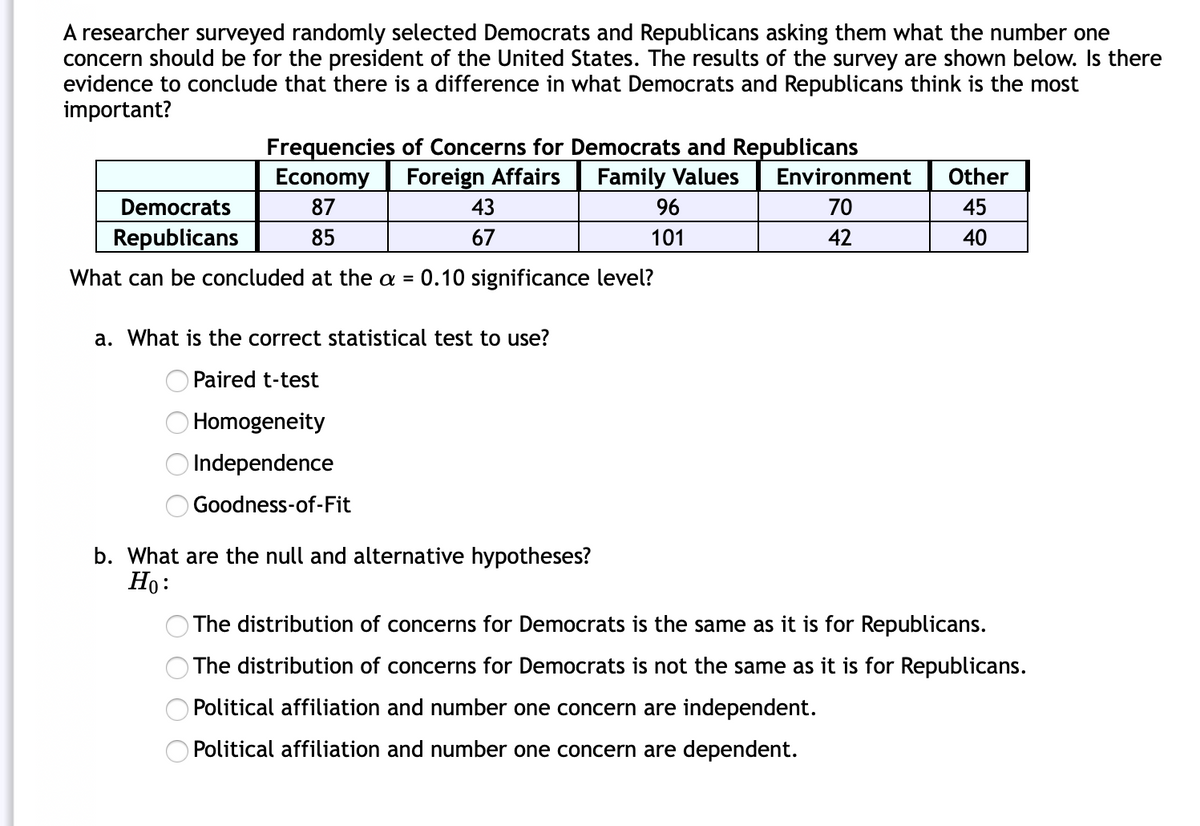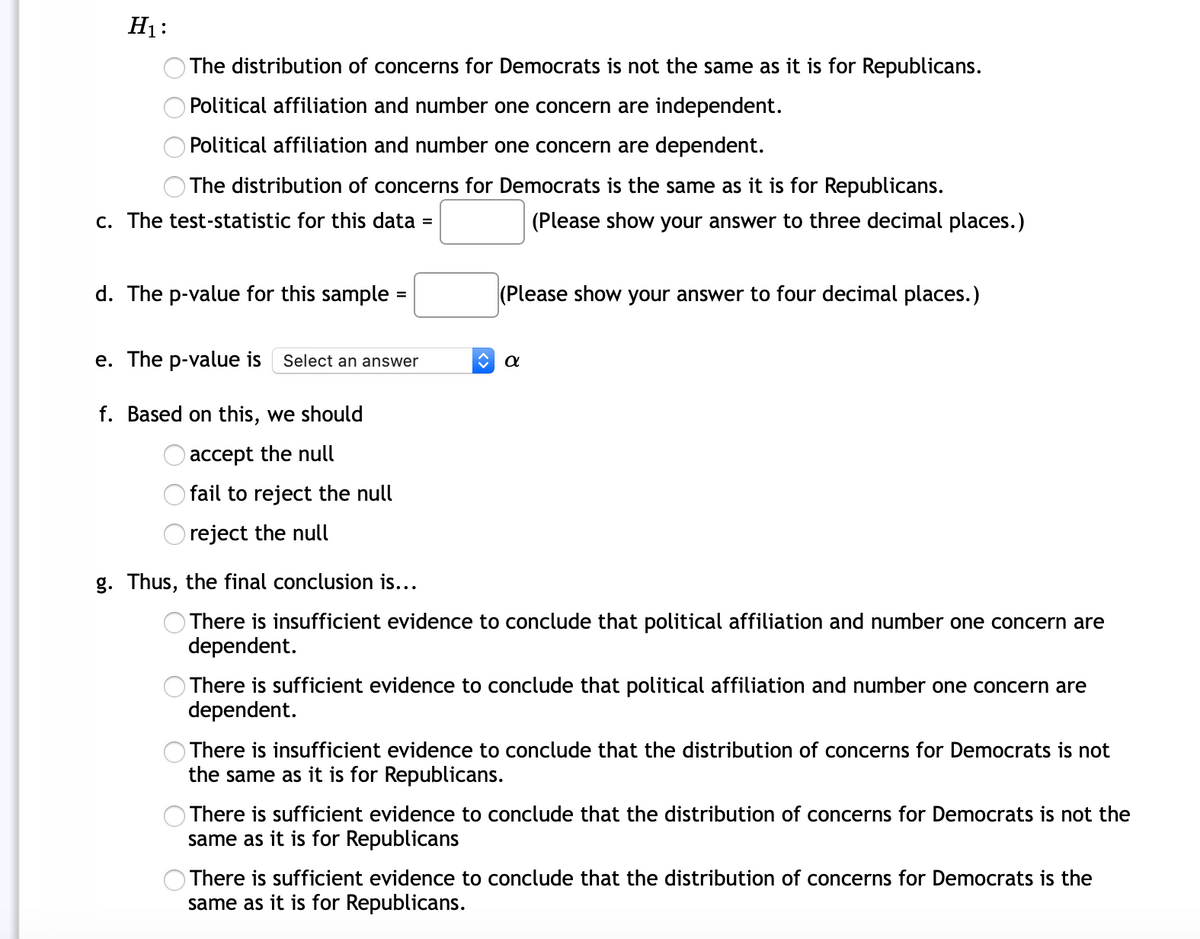A researcher surveyed randomly selected Democrats and Republicans asking them what the number one concern should be for the president of the United States. The results of the survey are shown below. Is there evidence to conclude that there is a difference in what Democrats and Republicans think is the most important? Frequencies of Concerns for Democrats and Republicans Economy Foreign Affairs Family Values Environment Other Democrats 87 43 96 70 45 Republicans 85 67 101 42 40 What can be concluded at the a = 0.10 significance level?
A researcher surveyed randomly selected Democrats and Republicans asking them what the number one concern should be for the president of the United States. The results of the survey are shown below. Is there evidence to conclude that there is a difference in what Democrats and Republicans think is the most important? Frequencies of Concerns for Democrats and Republicans Economy Foreign Affairs Family Values Environment Other Democrats 87 43 96 70 45 Republicans 85 67 101 42 40 What can be concluded at the a = 0.10 significance level?
College Algebra (MindTap Course List)
12th Edition
ISBN:9781305652231
Author:R. David Gustafson, Jeff Hughes
Publisher:R. David Gustafson, Jeff Hughes
Chapter8: Sequences, Series, And Probability
Section8.7: Probability
Problem 58E: What is meant by the sample space of an experiment?
Related questions
Topic Video
Question
100%

Transcribed Image Text:A researcher surveyed randomly selected Democrats and Republicans asking them what the number one
concern should be for the president of the United States. The results of the survey are shown below. Is there
evidence to conclude that there is a difference in what Democrats and Republicans think is the most
important?
Frequencies of Concerns for Democrats and Republicans
Economy
Foreign Affairs
Family Values
Environment
Other
Democrats
87
43
96
70
45
Republicans
85
67
101
42
40
What can be concluded at the a =
0.10 significance level?
a. What is the correct statistical test to use?
Paired t-test
Homogeneity
O Independence
Goodness-of-Fit
b. What are the null and alternative hypotheses?
Ho:
The distribution of concerns for Democrats is the same as it is for Republicans.
The distribution of concerns for Democrats is not the same as it is for Republicans.
Political affiliation and number one concern are independent.
Political affiliation and number one concern are dependent.

Transcribed Image Text:H1:
The distribution of concerns for Democrats is not the same as it is for Republicans.
Political affiliation and number one concern are independent.
Political affiliation and number one concern are dependent.
O The distribution of concerns for Democrats is the same as it is for Republicans.
c. The test-statistic for this data =
(Please show your answer to three decimal places.)
d. The p-value for this sample :
(Please show your answer to four decimal places.)
e. The p-value is
Select an answer
f. Based on this, we should
accept the null
fail to reject the null
reject the null
g. Thus, the final conclusion is...
There is insufficient evidence to conclude that political affiliation and number one concern are
dependent.
There is sufficient evidence to conclude that political affiliation and number one concern are
dependent.
There is insufficient evidence to conclude that the distribution of concerns for Democrats is not
the same as it is for Republicans.
There is sufficient evidence to conclude that the distribution of concerns for Democrats is not the
same as it is for Republicans
There is sufficient evidence to conclude that the distribution of concerns for Democrats is the
same as it is for Republicans.
Expert Solution
This question has been solved!
Explore an expertly crafted, step-by-step solution for a thorough understanding of key concepts.
This is a popular solution!
Trending now
This is a popular solution!
Step by step
Solved in 2 steps

Knowledge Booster
Learn more about
Need a deep-dive on the concept behind this application? Look no further. Learn more about this topic, statistics and related others by exploring similar questions and additional content below.Recommended textbooks for you

College Algebra (MindTap Course List)
Algebra
ISBN:
9781305652231
Author:
R. David Gustafson, Jeff Hughes
Publisher:
Cengage Learning


College Algebra (MindTap Course List)
Algebra
ISBN:
9781305652231
Author:
R. David Gustafson, Jeff Hughes
Publisher:
Cengage Learning
